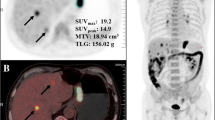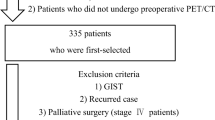Abstract
The present study aimed to investigate the prognostic value of intra-tumor metabolic heterogeneity on 2-[18F] Fluoro-2-deoxy-d-glucose (18F-FDG) positron emission tomography/computed tomography (PET/CT) for patients with gastric cancer. Fifty-five patients with advanced gastric cancer that had received neoadjuvant chemotherapy and radical surgery were included. Clinicopathological information, 18F-FDG PET/CT before chemotherapy, pathological response, recurrence or metastasis, progression-free survival (PFS), and overall survival (OS) of the patients were collected. The maximum, peak, and mean standardized uptake values (SUVmax, SUVpeak, and SUVmean), tumor-to-liver ratio (TLR), metabolic tumor volume (MTV), and total lesion glycolysis (TLG) on PET/CT were measured. Heterogeneity index-1 (HI-1) was calculated as SUVmean divided by the standard deviation, and heterogeneity index-2 (HI-2) was evaluated through linear regressions of MTVs according to different SUV thresholds. Associations between these parameters and patient survival outcomes were analyzed. None of the parameters on PET were associated with tumor recurrence. Pathological responders had significantly smaller TLR, MTV and HI-2 values than non-responders (P = 0.017, 0.017 and 0.013, respectively). In multivariate analysis of PFS, only HI-2 was an independent factor (hazard ratio [HR] = 2.693, P = 0.005) after adjusting for clinical tumor-node-metastasis (TNM) stage. In multivariate analysis of OS, HI-2 was also an independent predictive factor (HR = 2.281, P = 0.009) after adjusting for tumor recurrence. Thus, HI-2 generated from baseline 18F-FDG PET/CT is significantly associated with survival of patients with gastric cancer. Preoperative assessment of HI-2 by 18F-FDG PET/CT might be promising to identify patients with poor prognosis.



Similar content being viewed by others
Availability of data and materials
The dataset used and/or analyzed in current study are available from the corresponding author on reasonable request.
Abbreviations
- 18F-FDG:
-
2-[18F] Fluoro-2-deoxy-d-glucose
- PET/CT:
-
Positron emission tomography/computed tomography
- SUVmax:
-
Maximum standard uptake value
- SUVpeak :
-
Peak standard uptake value
- MTV:
-
Metabolic tumor volume
- TLG:
-
Total lesion glycolysis
- TLR:
-
Tumor-to-liver ratio
- HI:
-
Heterogeneity index
- VOI:
-
Volume of interest
- PFS:
-
Progression-free survival
- OS:
-
Overall survival
- HR:
-
Hazard ratio
- WDA:
-
Well differentiated adenocarcinoma
- MDA:
-
Moderate differentiated adenocarcinoma
- PDA:
-
Poorly differentiated adenocarcinoma
- SRC:
-
Signet-ring cell carcinoma
- MAC:
-
Mucinous adenocarcinoma
References
Torre LA, Bray F, Siegel RL, Ferlay J, Lortet-Tieulent J, Jemal A. Global cancer statistics, 2012. CA Cancer J Clin. 2015;65:87–108.
Park I, Ryu M, Choi Y, et al. A phase II study of neoadjuvant docetaxel, oxaliplatin, and S-1 (DOS) chemotherapy followed by surgery and adjuvant S-1 chemotherapy in potentially resectable gastric or gastroesophageal junction adenocarcinoma. Cancer Chemother Pharmacol. 2013;72:815–23.
Boige V, Pignon J, Saint-Aubert B, et al. Final results of a randomized trial comparing preoperative 5-fluorouracil (F)/cisplatin (P) to surgery alone in adenocarcinoma of stomach and lower esophagus (ASLE): FNLCC ACCORD07-FFCD 9703 trial. J Clin Oncol. 2007;25:4510.
Cunningham D, Allum WH, Stenning SP, et al. Perioperative chemotherapy versus surgery alone for resectable gastroesophageal cancer. N Engl J Med. 2006;355:11–20.
Wang C, Guo W, Zhou M, et al. The predictive and prognostic value of early metabolic response assessed by positron emission tomography in advanced gastric cancer treated with chemotherapy. Clin Cancer Res. 2016;22:1603–10.
Lee JW, Lee SM, Son MW, Lee MS. Diagnostic performance of FDG PET/CT for surveillance in asymptomatic gastric cancer patients after curative surgical resection. Eur J Nucl Med Mol Imaging. 2016;43:881–8.
Kim J, Lim ST, Na CJ, et al. Pretreatment F-18 FDG PET/CT parameters to evaluate progression-free survival in gastric cancer. Nucl Med Mol Imaging. 2014;48:33–40.
Sun G, Cheng C, Li X, Wang T, Yang J, Li D. Metabolic tumor burden on postsurgical PET/CT predicts survival of patients with gastric cancer. Cancer Imaging. 2019;19:18.
Tang L, Wang XJ, Baba H, Giganti F. Gastric cancer and image-derived quantitative parameters: part 2-a critical review of DCE-MRI and (18)F-FDG PET/CT findings. Eur Radiol. 2020;30:247–60.
Na SJ, O JH, Park JM, et al. Prognostic value of metabolic parameters on preoperative 18F-fluorodeoxyglucose positron emission tomography/computed tomography in patients with stage III gastric cancer. Oncotarget. 2016; 7:63968–80.
Park JS, Lee N, Beom SH, et al. The prognostic value of volume-based parameters using (18)F-FDG PET/CT in gastric cancer according to HER2 status. Gastric Cancer. 2018;21:213–24.
Park S, Ha S, Kwon HW, et al. Prospective evaluation of changes in tumor size and tumor metabolism in patients with advanced gastric cancer undergoing chemotherapy: association and clinical implication. J Nucl Med. 2017;58:899–904.
Razzak M. Genetics: new molecular classification of gastric adenocarcinoma proposed by The Cancer Genome Atlas. Nat Rev Clin Oncol. 2014;11:499.
Giganti F, Antunes S, Salerno A, et al. Gastric cancer: texture analysis from multidetector computed tomography as a potential preoperative prognostic biomarker. Eur Radiol. 2017;27:1831–9.
Li M, Ke J, Wang Q, et al. Upregulation of ROCK2 in gastric cancer cell promotes tumor cell proliferation, metastasis and invasion. Clin Exp Med. 2017;17:519–29.
Ohbatake Y, Fushida S, Tsukada T, et al. Elevated alpha1-acid glycoprotein in gastric cancer patients inhibits the anticancer effects of paclitaxel, effects restored by co-administration of erythromycin. Clin Exp Med. 2016;16:585–92.
Asselin MC, O’Connor JP, Boellaard R, Thacker NA, Jackson A. Quantifying heterogeneity in human tumours using MRI and PET. Eur J Cancer. 2012;48:447–55.
Kim YI, Kim YJ, Paeng JC, et al. Heterogeneity index evaluated by slope of linear regression on (18)F-FDG PET/CT as a prognostic marker for predicting tumor recurrence in pancreatic ductal adenocarcinoma. Eur J Nucl Med Mol Imaging. 2017;44:1995–2003.
Huang B, Chan T, Kwong DL, Chan WK, Khong PL. Nasopharyngeal carcinoma: investigation of intratumoral heterogeneity with FDG PET/CT. AJR Am J Roentgenol. 2012;199:169–74.
Kim TH, Yoon JK, Kang DK, et al. Correlation between F-18 fluorodeoxyglucose positron emission tomography metabolic parameters and dynamic contrast-enhanced MRI-derived perfusion data in patients with invasive ductal breast carcinoma. Ann Surg Oncol. 2015;22:3866–72.
Kwon SH, Yoon JK, An YS, et al. Prognostic significance of the intratumoral heterogeneity of F-18-FDG uptake in oral cavity cancer. J Surg Oncol. 2014;110:702–6.
Chung HH, Kang SY, Ha S, et al. Prognostic value of preoperative intratumoral FDG uptake heterogeneity in early stage uterine cervical cancer. J Gynecol Oncol. 2016;27:e15.
Japanese Gastric Cancer Association. Japanese classification of gastric carcinoma: 3rd English edition. Gastric Cancer. 2011; 14:101–12.
Lee M, Lee H, Cheon GJ, et al. Prognostic value of preoperative intratumoral FDG uptake heterogeneity in patients with epithelial ovarian cancer. Eur Radiol. 2017;27:16–23.
Ajani JA, Barthel JS, Bekaii-Saab T, et al. Gastric cancer. J Natl Compr Canc Netw. 2010;8:378–409.
Schwartz LH, Litiere S, de Vries E, et al. RECIST 1.1-Update and clarification: From the RECIST committee. Eur J Cancer. 2016; 62:132–7.
Sorensen M, Horsman MR, Cumming P, Munk OL, Keiding S. Effect of intratumoral heterogeneity in oxygenation status on FMISO PET, autoradiography, and electrode Po2 measurements in murine tumors. Int J Radiat Oncol Biol Phys. 2005;62:854–61.
Gerlinger M, Rowan AJ, Horswell S, et al. Intratumor heterogeneity and branched evolution revealed by multiregion sequencing. N Engl J Med. 2012;366:883–92.
Tateishi U, Nishihara H, Tsukamoto E, Morikawa T, Tamaki N, Miyasaka K. Lung tumors evaluated with FDG-PET and dynamic CT: the relationship between vascular density and glucose metabolism. J Comput Assist Tomogr. 2002;26:185–90.
Basu S, Kwee T, Gatenby R, Saboury B, Torigian D, Alavi A. Evolving role of molecular imaging with PET in detecting and characterizing heterogeneity of cancer tissue at the primary and metastatic sites, a plausible explanation for failed attempts to cure malignant disorders. Eur J Nucl Med Mol Imaging. 2011;38:987–91.
Hyun SH, Kim HS, Choi SH, et al. Intratumoral heterogeneity of 18F-FDG uptake predicts survival in patients with pancreatic ductal adenocarcinoma. Eur J Nucl Med Mol I. 2016;43:1461–8.
Chicklore S, Goh V, Siddique M, Roy A, Marsden PK, Cook GJR. Quantifying tumour heterogeneity in 18F-FDG PET/CT imaging by texture analysis. Eur J Nucl Med Mol I. 2013;40:133–40.
Hatt M, Majdoub M, Vallières M, et al. 18F-FDG PET uptake characterization through texture analysis: investigating the complementary nature of heterogeneity and functional tumor volume in a multi–cancer site patient cohort. J Nucl Med. 2015;56:38–44.
Wang SL, Cao S, Sun YN, et al. Standardized uptake value on positron emission tomography/computed tomography predicts prognosis in patients with locally advanced pancreatic cancer. Abdom Imaging. 2015;40:3117–21.
Chirindel A, Alluri KC, Chaudhry MA, et al. Prognostic value of FDG PET/CT-derived parameters in pancreatic adenocarcinoma at initial PET/CT staging. AJR Am J Roentgenol. 2015;204:1093–9.
Choi HJ, Kang CM, Jo K, et al. Prognostic significance of standardized uptake value on preoperative (1)(8)F-FDG PET/CT in patients with ampullary adenocarcinoma. Eur J Nucl Med Mol Imaging. 2015;42:841–7.
Thie JA. Understanding the standardized uptake value, its methods, and implications for usage. J Nucl Med. 2004;45:1431–4.
Acknowledgements
The authors would like to express their gratitude to the staff of the Department of Nulcear Medicine of Zhongshan Hospital, Fudan University, for the support of this study.
Funding
This study was funded by the National Natural Science Foundation of China (Grant Number: 81701730), the training program for excellent young medical talents of Zhongshan Hospital of Fudan University (Grant Number: 2019ZSYQ28), and the Shanghai “Rising Stars of Medical Talent”—–Youth Development Program (Grant Number: HWJRS2019-72). The funding body had no role in the design, data collection, analysis, interpretation or manuscript writing of this study.
Author information
Authors and Affiliations
Contributions
GL and YH conceived and wrote this article. GL, HY, and XC collected the study materials or patients. XC, YW and YH performed the data analysis and interpretation. TL and HS controlled the quality of the study. All authors have read and approved the manuscript for publication.
Corresponding authors
Ethics declarations
Competing interests
The authors declare that there is no conflict of interest regarding this article.
Ethics approval and consent to participate
This study was approved by the Ethics Committee of Zhongshan Hospital of Fudan University (Approval Number: IRB2015-098). Written informed consents were obtained from all patients.
Consent for publication
Written informed consents were obtained from included patients for publication.
Additional information
Publisher's Note
Springer Nature remains neutral with regard to jurisdictional claims in published maps and institutional affiliations.
Rights and permissions
About this article
Cite this article
Liu, G., Yin, H., Cheng, X. et al. Intra-tumor metabolic heterogeneity of gastric cancer on 18F-FDG PETCT indicates patient survival outcomes. Clin Exp Med 21, 129–138 (2021). https://doi.org/10.1007/s10238-020-00659-8
Received:
Accepted:
Published:
Issue Date:
DOI: https://doi.org/10.1007/s10238-020-00659-8




